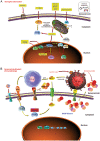Targeting Senescent Cells for a Healthier Aging: Challenges and Opportunities
- PMID: 33304768
- PMCID: PMC7709980
- DOI: 10.1002/advs.202002611
Targeting Senescent Cells for a Healthier Aging: Challenges and Opportunities
Abstract
Aging is a physiological decline in both structural homeostasis and functional integrity, progressively affecting organismal health. A major hallmark of aging is the accumulation of senescent cells, which have entered a state of irreversible cell cycle arrest after experiencing inherent or environmental stresses. Although cellular senescence is essential in several physiological events, it plays a detrimental role in a large array of age-related pathologies. Recent biomedical advances in specifically targeting senescent cells to improve healthy aging, or alternatively, postpone natural aging and age-related diseases, a strategy termed senotherapy, have attracted substantial interest in both scientific and medical communities. Challenges for aging research are highlighted and potential avenues that can be leveraged for therapeutic interventions to control aging and age-related disorders in the current era of precision medicine.
Keywords: aging; clinical trials; healthspan; senescent cells; senolytics; senotherapy.
© 2020 The Authors. Published by Wiley‐VCH GmbH.
Conflict of interest statement
J.L.K. has a financial interest related to this research. Patents on senolytic drugs are held by Mayo Clinic. This research has been reviewed by the Mayo Clinic Conflict of Interest Review Board and was conducted in compliance with Mayo Clinic Conflict of Interest policies.
Figures



Similar articles
-
Cellular Senescence in Diabetes Mellitus: Distinct Senotherapeutic Strategies for Adipose Tissue and Pancreatic β Cells.Front Endocrinol (Lausanne). 2022 Mar 31;13:869414. doi: 10.3389/fendo.2022.869414. eCollection 2022. Front Endocrinol (Lausanne). 2022. PMID: 35432205 Free PMC article. Review.
-
Targeting normal and cancer senescent cells as a strategy of senotherapy.Ageing Res Rev. 2019 Nov;55:100941. doi: 10.1016/j.arr.2019.100941. Epub 2019 Aug 10. Ageing Res Rev. 2019. PMID: 31408714 Review.
-
Senescent cells as a target for anti-aging interventions: From senolytics to immune therapies.J Transl Int Med. 2025 Mar 19;13(1):33-47. doi: 10.1515/jtim-2025-0005. eCollection 2025 Feb. J Transl Int Med. 2025. PMID: 40115034 Free PMC article.
-
Targeting senescent cells for a healthier longevity: the roadmap for an era of global aging.Life Med. 2022 Aug 9;1(2):103-119. doi: 10.1093/lifemedi/lnac030. eCollection 2022 Oct. Life Med. 2022. PMID: 36699942 Free PMC article. Review.
-
Diverse Roles of Cellular Senescence in Skeletal Muscle Inflammation, Regeneration, and Therapeutics.Front Pharmacol. 2021 Sep 6;12:739510. doi: 10.3389/fphar.2021.739510. eCollection 2021. Front Pharmacol. 2021. PMID: 34552495 Free PMC article. Review.
Cited by
-
Endothelial senescence in vascular diseases: current understanding and future opportunities in senotherapeutics.Exp Mol Med. 2023 Jan;55(1):1-12. doi: 10.1038/s12276-022-00906-w. Epub 2023 Jan 4. Exp Mol Med. 2023. PMID: 36599934 Free PMC article. Review.
-
Colchicine Protects against Ethanol-Induced Senescence and Senescence-Associated Secretory Phenotype in Endothelial Cells.Antioxidants (Basel). 2023 Apr 19;12(4):960. doi: 10.3390/antiox12040960. Antioxidants (Basel). 2023. PMID: 37107335 Free PMC article.
-
Biomarkers of aging.Sci China Life Sci. 2023 May;66(5):893-1066. doi: 10.1007/s11427-023-2305-0. Epub 2023 Apr 11. Sci China Life Sci. 2023. PMID: 37076725 Free PMC article. Review.
-
Strategies for late phase preclinical and early clinical trials of senolytics.Mech Ageing Dev. 2021 Dec;200:111591. doi: 10.1016/j.mad.2021.111591. Epub 2021 Oct 23. Mech Ageing Dev. 2021. PMID: 34699859 Free PMC article. Review.
-
Hallmarks and Biomarkers of Skin Senescence: An Updated Review of Skin Senotherapeutics.Antioxidants (Basel). 2023 Feb 10;12(2):444. doi: 10.3390/antiox12020444. Antioxidants (Basel). 2023. PMID: 36830002 Free PMC article. Review.
References
Publication types
Grants and funding
LinkOut - more resources
Full Text Sources
Other Literature Sources
